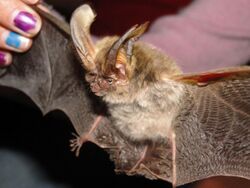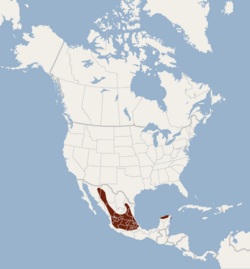Biology:Mexican big-eared bat
| Mexican big-eared bat | |
|---|---|

| |
| In Michoacán, Mexico | |
| Scientific classification | |
| Domain: | Eukaryota |
| Kingdom: | Animalia |
| Phylum: | Chordata |
| Class: | Mammalia |
| Order: | Chiroptera |
| Family: | Vespertilionidae |
| Genus: | Corynorhinus |
| Species: | C. mexicanus
|
| Binomial name | |
| Corynorhinus mexicanus G.M. Allen, 1916
| |

| |
| Synonyms | |
|
Plecotus mexicanus (G.M. Allen, 1916) | |
The Mexican big-eared bat (Corynorhinus mexicanus) is a species of vesper bat endemic to Mexico.[1][2][3] They are nocturnal and insectivorous. Their very large ears are located across their foreheads, and when captured, the bats are observed to curl their ears in a protective manner.[4] The adults are usually brown colored, while the juveniles are usually a smokey brown color. They have small noses.[5]
Habitat and distribution
The Mexican big-eared bat endemic to Mexico and known between Sonora and Coahuila in the north and Michoacan Yucatán in the south;[1][2] it is rare in the southern end of its range and uncommon elsewhere.[1] They are found in high, humid, mountain habitats and seem to prefer areas with pine-oak forests,[6] although they have been found around other types of vegetation, such as sycamore, cottonwood and agave.[4] Being a nocturnal species, they rest during the day; their day-time roosts are in open caves[4] and mine shafts.[7]
Reproduction
Studies of the males of the species show they have one long reproductive cycle per year. The timing of their cycle is dependent on both physiological (body condition, neurological, and endocrine signals) and environmental (temperature and resource availability) factors. The male reproductive organs are the smallest in February, March, and April, then begin development in May and reach their biggest size, determined by weight, around August (where they are about 40 times bigger than they were in April). The best body conditions of the bats were found from May to June, which suggests this cycle is dependent on body condition.[8] Females give birth to a single offspring.[3]
Status
In 1996, the species was listed as lower risk/least concern, but in 2008, it was moved to near threatened. The population sizes of this bat are declining, and the species may soon be threatened.[1] The major threat to the species is humans, disturbing their roosts and causing habitat loss.[9]
See also
- Bats of the United States
References
- ↑ 1.0 1.1 1.2 1.3 1.4 Solari, S. (2019). "Corynorhinus mexicanus". IUCN Red List of Threatened Species 2019: e.T17599A21976792. doi:10.2305/IUCN.UK.2019-3.RLTS.T17599A21976792.en. https://www.iucnredlist.org/species/17599/21976792. Retrieved 17 November 2021.
- ↑ 2.0 2.1 Wilson, D.E.; Reeder, D.M., eds (2005). Mammal Species of the World: A Taxonomic and Geographic Reference (3rd ed.). Johns Hopkins University Press. ISBN 978-0-8018-8221-0. OCLC 62265494. http://www.departments.bucknell.edu/biology/resources/msw3/browse.asp?id=13802137.
- ↑ 3.0 3.1 "Corynorhinus mexicanus Mexican Big-eared Bat". North American Mammals. National Museum of Natural History (NMNH). http://naturalhistory.si.edu/mna/image_info.cfm?species_id=543.
- ↑ 4.0 4.1 4.2 Commissaris, L.R. (1961). "The Mexican Big-Eared Bat in Arizona". Journal of Mammalogy 42 (1): 61–65. doi:10.2307/1377242.
- ↑ Allen, G.M. (1916). "Bats of the genus Corynorhinus". Bulletin of the Museum of Comparative Zoology 60: 331–356. https://archive.org/details/cbarchive_106699_batsofthegenuscorynorhinus1863.
- ↑ Handley, C.O. (1955). "A new pleistocene bat (Corynorhinus) from Mexico". Journal of the Washington Academy of Sciences 45: 48–49. http://biostor.org/reference/105850.
- ↑ Anderson, S. (1972). "Mammals of Chihuahua, taxonomy and distribution". Bulletin of the American Museum of Natural History 148: 149–410.
- ↑ Miguel, A.L.G.; López-Wilchis, Ricardo; Hernández-Pérez, Omar; Arenas-Ríos, Edith; Rosado, Adolfo (2005). Edwards, Cody. ed. "Male reproductive cycle of Mexican big-eared bats, Corynorhinus mexicanus (Chiroptera: Vespertilionidae)". The Southwestern Naturalist 50 (4): 453–460. doi:10.1894/0038-4909(2005)050[0453:MRCOMB2.0.CO;2].
- ↑ Ceballos, G. and Oliva, G. 2005. Los mamíferos silvestres de México. Comisión Nacional para el Conocimiento y Uso de la Biodiversidad and Fondo de Cultura Económica, México.
Wikidata ☰ Q1833151 entry
 |


